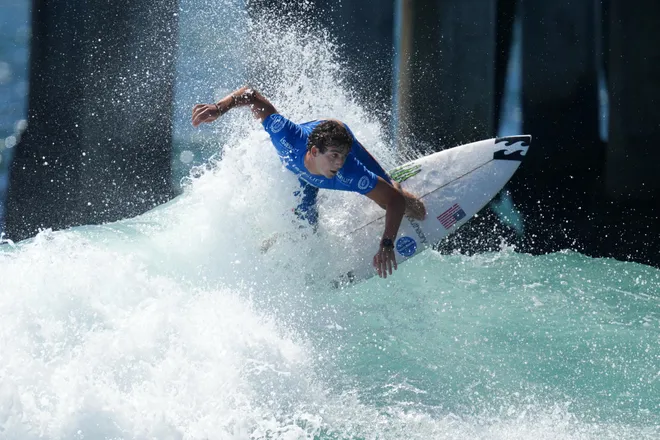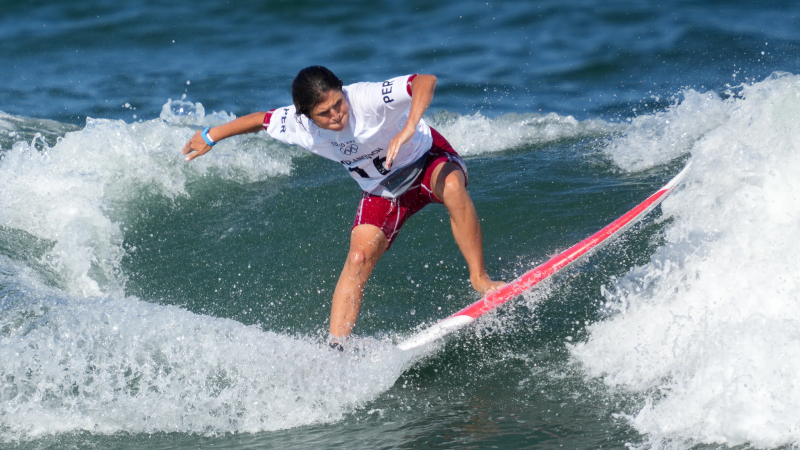Paris Games could include the sight of helmet-wearing surfers on huge waves in Tahiti
The 2024 Summer Olympics could include a unique sight: surfers wearing helmets.
Griffin Colapinto, a member of the U.S. Olympic team, said he wore one last week. His concern is the risk of head injuries while riding waves over the shallow coral reef in Tahiti, the competition site for the Paris Games.
“So far my experience has been that you can pretty much get the best wave of your whole life at the risk of dying,’’ Colapinto told USA TODAY Sports. “I think there will be a good amount of helmets by the time the competition starts.’’
Competitive surfing, to be held at the French Polynesian island starting July 27 after making its Olympic debut at the Tokyo Games, will involve fears – and not just over the sharp coral reef and waves that can reach more than 20 feet high.
There also are environmental concerns over the judges’ tower.
A three-story structure, built at a cost of $5 million, stands in the clear island water. The location is about 100 yards from a legendary surfing spot and not far from where protesters marched last year.
Some local residents expressed fear the tower would damage Tahiti's coral reef and ecosystem. And an online petition opposing the tower's construction drew support well beyond the shores of Tahiti, with the number of signatures having topped 250,000.
The tower will be used for the first time Wednesday with the World Surf League (WSL) scheduled to open its annual Championship Tour stop in Tahiti. The field will include Colapinto, currently No. 1 in the WSL men's rankings, and more than a dozen other surfers who will compete in Tahiti again during the Olympics
.
Why Tahiti is the site for Olympic surfing
Paris isn’t exactly a hotbed for surfing. The capital of France is at least a two-hour drive from the sea, and during the summer the quality of waves are not suitable for elite competition.
So Olympic organizers awarded the surfing venue to Tahiti, the island in the southern Pacific Ocean with massive swells and powerful waves. The best break is off the shores of Teahupo’o, a village of about 1,500.
It will be the temporary home for 48 Olympic surfers, including American Carissa Moore, the defending women's gold medalist.
The lush, tropical topography and barrel-riding, with surfers traveling at high speeds inside the hollowed-out waves, are sure to dazzle TV viewers.
“It’s one of the most magical places in the world,’’ said Caroline Marks, a member of the U.S. Olympic team and the 2023 WSL Women's World Tour Champion. “It can be a pretty scary wave, but also so incredible.
“You could be getting some of the best waves of your life and competing for a gold medal. That sounds pretty darn good.”
How dangerous are the waves in Tahiti?
Water hundreds of feet deep about ⅓ mile off of the shore of Teahupo'o generates waves that gain power as they travel from the deep water to the shallow reefs, explained Colapinto.
“It creates like this wild surge and the wave gets super thick,’’ he said. “There’s just so much energy and force behind it, and that’s what makes it so dangerous.’’

The only recorded surfing death at Teapuho'o took place in 2000. Tahitian surfer Briece Taerea plunged off the falls of a 12-foot wave and landed head-first on the shallow reef, according to Surfer Today and other published reports.
Serious injuries are not uncommon.
About a year ago, for example, big wave surfer Tom Lowe wiped out and landed on the reef. He suffered internal bleeding, a fractured scapula and five broken ribs, according to the BBC.
“If you hit the bottom, you’re like guaranteed to get cut,’’ Colapinto said, recalling his experiment wearing the helmet. “It was kind of hard because if you do fall, the wave kind of rag-dolls you super hard and having that helmet on your head tweaks your neck around. Sometimes it can almost be more dangerous.’’
Colapinto did not say if he would wear a helmet during Olympic competition, but noted the sight of helmet-wearing surfers “seems to be trending.’’
Why Tahitians opposed the new judges' tower
A wooden judges' tower that had been used for more than 20 years has been dismantled.
After awarding the surfing venue to Tahiti, Olympic organizers deemed the wooden structure unsafe and unveiled plans to build a 14-ton, aluminum tower.
In October, a group of local residents pushed back. About 500 of them marched in protest and legendary Tahitian surfer Matahi Drollet posted a video online detailing concerns including the potential damage or destruction to the reef.
The Olympic organizers and French Polynesian government agreed to scale back the tower by 25 percent. It includes electricity, running water for toilets, high-speed internet cable and the capacity for 40 people.
"After a change in the size of the tower, and many discussions, the tower was accepted by the population and was built without problems or damage,'' Corinne Raybaud, the author of more than a dozen books on Tahiti, told USA TODAY Sports. "It was a principled opposition to something new."
The tower’s debut during the WSL competition starting Wednesday will offer a chance to assess how locals feel about what's transpired.

Logistically, how will surfing competition work away from Paris?
The surfers will not be able to attend the Opening Ceremonies but will have the option of attending the final week of the Games and the Closing Ceremonies. Life in the Olympic Village definitely will contrast with life in the village of Teahupo'o.
There are no hotels and only two restaurants. The U.S. Olympic team will stay at a home owned by locals, have their own chef and, according to Colapinto, enjoy a spectacular view.
“We’re looking straight into the wave,’’ he said. “Literally a one-minute jet ski ride to the wave. It’s pretty rad.’’
It’ll be a departure from the sport's Olympic debut, when surfers rode smaller, choppy waves outside of Tokyo and showed off their aerial maneuvers. Kanoa Igarashi, the Japanese American surfer who won the silver medal there while representing Japan, said he knows what it’ll take to win gold.
“It really favors a surfer that has a special connection with the ocean,’’ he said. “Tahiti is one of those places, the island has so much power and has so much energy. It almost feels really, really spiritual.
“To pick the winner, it really depends what kind of waves you catch, what kind of rhythm you’re in. There are so many things that have to go your way other than Mother Nature, that it’s a very unique venue and that is the beauty of competing in such a raw, special place like Tahiti.’’
Follow Josh Peter on social media @joshlpeter11
Disclaimer: The copyright of this article belongs to the original author. Reposting this article is solely for the purpose of information dissemination and does not constitute any investment advice. If there is any infringement, please contact us immediately. We will make corrections or deletions as necessary. Thank you.







